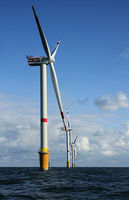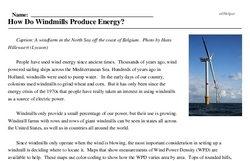How Do Windmills Produce Energy?
Caption: A windfarm in the North Sea off the coast of Belgium. Photo by Hans Hillewaert (Lycaon)
People have used wind energy since ancient times. Thousands of years ago, wind powered sailing ships across the Mediterranean Sea. Hundreds of years ago in Holland, windmills were used to pump water. In the early days of our country, colonists used windmills to grind wheat and corn. But it has only been since the energy crisis of the 1970s that people have really taken an interest in using windmills as a source of electric power.
Windmills only provide a small percentage of our power, but their use is growing. Windmill farms with rows and rows of giant windmills can be seen in states all across the United States, as well as in countries all around the world.
Since windmills only operate when the wind is blowing, the most important consideration in setting up a windmill is deciding where to locate it. Maps that show measurements of Wind Power Density (WPD) are available to help. These maps use color-coding to show how the WPD varies area by area. Tops of rounded hills, open plains, and shorelines are all good locations because they often have high WPD.
The large windmills used today to produce electric power are called turbines. They are built with narrow blades but are tall and wide to capture as much wind as possible. The wingspan of the blades can be anywhere from a few feet to a few hundred feet. The largest ones have blades as long as a football field.




